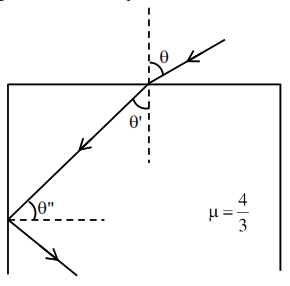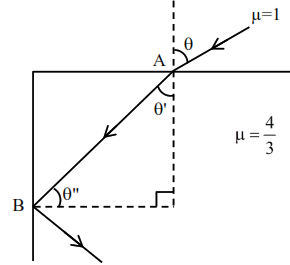A ray of light entering from air into a denser medium of refractive index $\frac{4}{3}$, as shown in figure. The light ray suffers total internal reflection at the adjacent surface as shown. The maximum value of angle $\theta$ should be equal to :

Correct Option: 1

At maximum angle $\theta$ ray at point B goes in gazing emergence, at all less values of $\theta$, TIR occurs.
At point B
$\frac{4}{3} \times \sin \theta^{\prime \prime}=1 \times \sin 90^{\circ}$
$\theta^{\prime \prime}=\sin ^{-1}\left(\frac{3}{4}\right)$
$\theta^{\prime}=\left(\frac{\pi}{2}-\theta^{\prime \prime}\right)$
At point $\mathrm{A}$
$1 \times \sin \theta=\frac{4}{3} \times \sin \theta^{\prime}$
$\sin \theta=\frac{4}{3} \times \sin \left(\frac{\pi}{2}-\theta^{\prime \prime}\right)$
$\sin \theta=\frac{4}{3} \cos \left[\cos ^{-1} \frac{\sqrt{7}}{4}\right]$

$\sin \theta=\frac{4}{3} \times \frac{\sqrt{7}}{4}$
$\theta=\sin ^{-1}\left(\frac{\sqrt{7}}{3}\right)$
Click here to get exam-ready with eSaral
For making your preparation journey smoother of JEE, NEET and Class 8 to 10, grab our app now.
